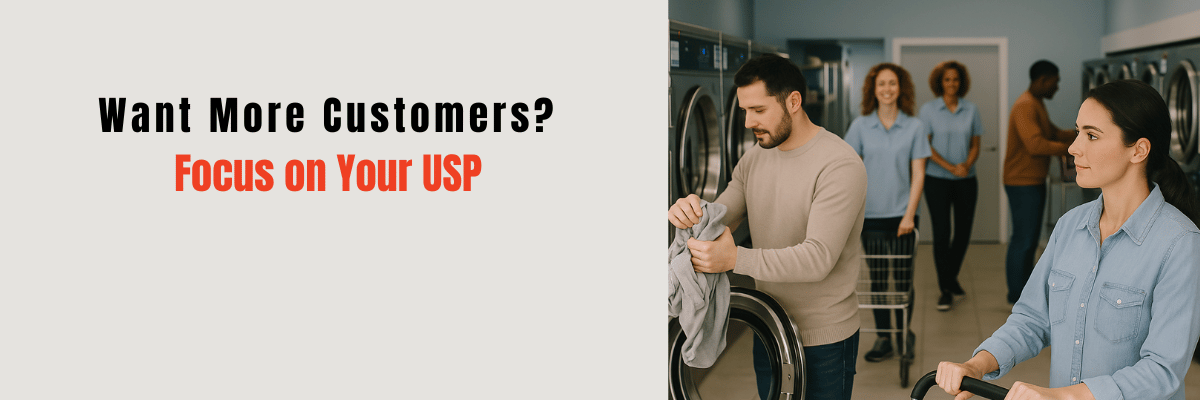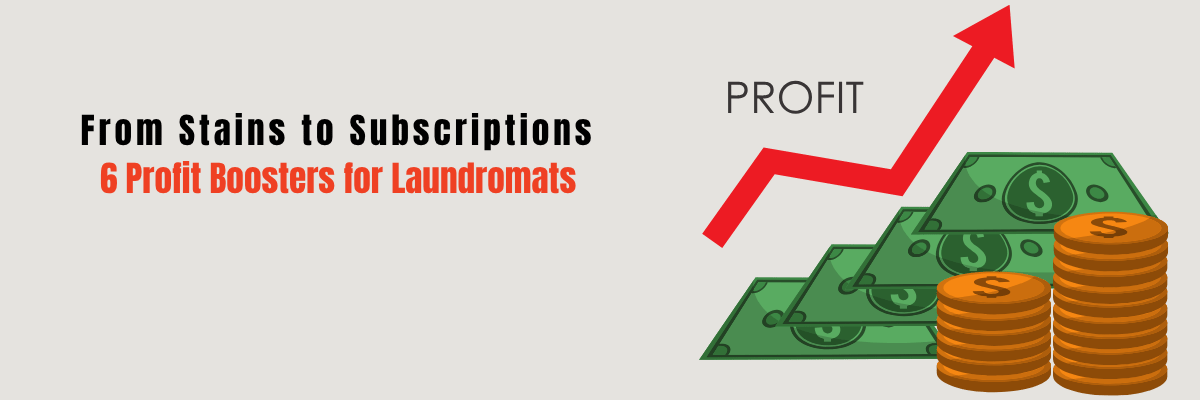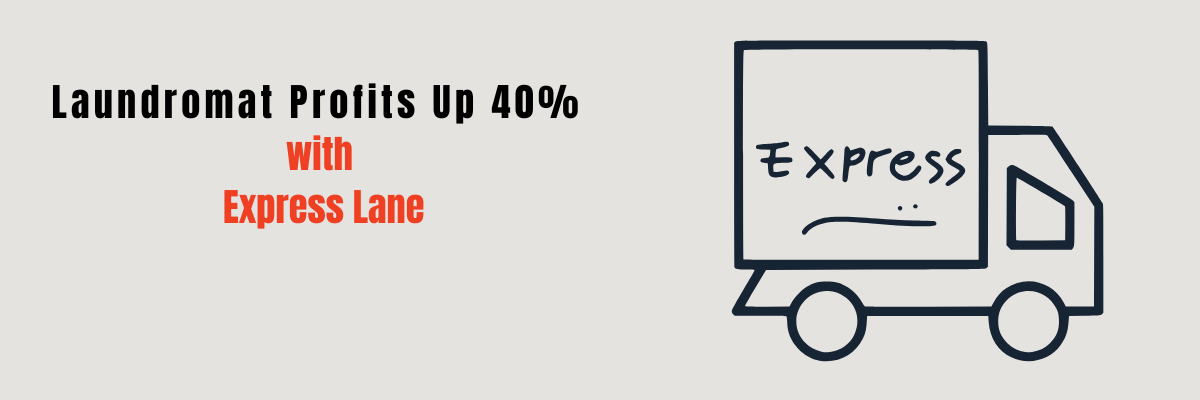Why Are USPs in Laundry Services the Key to Earning More Profit and Winning More Customers?


Let me tell you something most laundromat and dry-cleaning owners don’t realize until it’s too late: you’re not just competing on who has the cleanest machines or the lowest prices. You’re fighting for customers who have more laundry options than ever before—from wash-and-fold services that pick up at their doorstep to subscription apps promising to change how they think about clean clothes.
And here’s the tough part: in today’s competitive era, you can’t just copy what your competitor is doing and expect to win. Customers don’t reward “sameness.” If you want higher profits and true recognition in your market, you need to carve out a space that’s uniquely yours.
So what separates a struggling laundromat from one with lines out the door? One word: USP.
Your Unique Selling Proposition isn’t marketing jargon—it’s your survival mechanism. It’s the reason someone drives past three other laundromats to get to yours. And if you don’t have one yet, you’re essentially asking customers to pick you at random. Spoiler alert: random doesn’t build loyal customer bases.

What Exactly Is a USP in Laundry Services?
Here’s the thing about USPs that most business guides get wrong: they make it sound complicated. It’s not.
Your USP is simply the answer to this question:
“Why should I choose your laundromat or dry cleaner over every other option available to me?”
Notice I didn’t say “Why should I choose you over the laundromat down the street?” Because your competition isn’t just other laundromats anymore. It’s:
• Home washing machines
• Mobile wash-and-fold services
• Dry cleaning chains with laundry add-ons
• College campus laundry facilities
• Apartment complex laundry rooms
• That neighbor with a really nice washer who lets friends use it
Your USP cuts through all of this noise and gives people a compelling reason to pick you. It’s not about being everything to everyone—it’s about being something specific to someone specific.
A Real-World Example
A laundromat in Seattle struggled for years with the usual setup: decent machines, reasonable prices, clean enough space. Then the owner noticed something—his neighborhood had exploded with young families, and every parent who came in looked absolutely exhausted. So he pivoted.
He installed a supervised kids’ play area, added a coffee bar, created a comfortable lounge, and branded the business as:
“Where Parents Get Their Sanity Back—One Load at a Time.”
Revenue jumped 67% in eight months. Same machines. Same building. A totally different business.
That’s the power of a well-executed USP.
How a Strong USP Enhances Your Profitability
Let’s talk money, because that’s what keeps your doors open.
Most owners think: “More customers = more profit.” But that’s the hardest way to grow. Acquiring new customers is expensive and unpredictable.
A strong USP flips the equation. It makes every customer more valuable, more loyal, and less price-sensitive.
1. Premium Pricing Without Pushback
When you’re “just another laundromat,” you’re stuck in a race to the bottom. With a strong USP, you escape that trap.
• A green laundromat in Portland charges 25% more than competitors. Customers gladly pay because it matches their eco-values.
• A hypoallergenic dry cleaner in New Jersey charges 90% more and has a waiting list. Parents of kids with eczema and customers with sensitive skin won’t go anywhere else.
Your USP isn’t “clean clothes.” It’s solving a specific, emotional pain point.
2. Customer Loyalty That Actually Means Something
Laundry customers are notoriously disloyal—until you give them a reason not to be.
USP-driven customers:
• Spend 5x more over their lifetime
• Cost less to acquire
• Are 6x more likely to refer friends
This isn’t theory. These numbers came from laundromats and dry cleaners that tracked results for two years.
3. Operational Efficiency Through Focus
Trying to serve everyone is chaos.
One Chicago laundromat offered same-day, budget overnight, commercial accounts, and wash-and-fold—all badly. When they narrowed to express speed, they:
• Upgraded machines
• Trained staff for efficiency
• Dropped services that didn’t fit
Result: 145% higher profit per square foot.
Clear USP = clear operations.
4. Marketing That Works
Generic ads: “Clean clothes. Friendly service. Low prices.”
USP ads:
• “Laundry ready in 90 minutes—guaranteed.”
• “Eco-friendly dry cleaning for couture gowns.”
• “The only laundromat where parents get their sanity back.”
One is forgettable. The other makes people stop and pay attention.
5. The Compound Effect
When premium pricing, loyalty, operational efficiency, and USP-driven marketing work together, results multiply.
Same size. Same machines. Only difference = USP.
The Different Types of USPs in Laundry & Dry Cleaning
Here’s the heart of it. Every thriving laundromat or dry cleaner has one clear USP. Not ten reasons. One.
Here are the 7 USP types that actually work:
1. Speed-Based USP
For customers who value time over price.
• 90-minute turnaround.
• Same-day pickup/delivery.
• “Text ahead, ready at the door.”
Example: A Chicago operator replaced half their machines with faster, larger units. Revenue/sq ft rose 145%.
2. Eco-Friendly USP
For customers who care about sustainability.
• Solar, water reclamation, biodegradable detergents.
• Compostable/reusable packaging.
• Transparent environmental reporting.
Example: A California dry cleaner branded itself as “the first toxin-free couture cleaner.” Brides and designers won’t go elsewhere.
3. Luxury USP
For customers who want the best, not the cheapest.
• Concierge service.
• Hand finishing.
• Boutique ambiance.
• Premium pricing.
Example: A Los Angeles cleaner turned their shop into a boutique-style lounge. Their wash-and-fold is 3x the price—and booked solid with execs and stylists.
4. Specialty USP
For niche markets that no one else serves.
• Technical fabrics & outdoor gear.
• Allergen-free cleaning.
• Pet bedding.
• Commercial uniforms.
Example: A Denver shop became the go-to for outdoor gear. Avg. ticket: $45 vs. $12. Customers drive 40 miles to reach them.
5. Tech & Convenience USP
• Branded mobile app.
• Smart lockers.
• Subscriptions.
• Real-time tracking.
Example: A San Francisco service has no storefront—just lockers + app. Low overhead, high recurring revenue.
6. Community USP
• Live music.
• Coffee & beer.
• Kids’ play zone.
• Co-working space.
Example: An Austin laundromat became a “third place.” Evenings went from dead to their busiest hours.
7. Price USP (Use with caution)
• Lowest cost.
• High volume.
Example: Works in extremely price-sensitive areas, but loyalty is nearly zero. Always vulnerable to undercutting.
USP Comparison
How to Choose & Implement Your USP
Step 1: Audit Your Business Honestly
• Why do customers choose you now?
• What do reviews say?
• Which services are profitable?
• What complaints repeat?
Step 2: Identify Your Target Personas
Example:
“Stressed-Out Sarah”
• 34, marketing manager, 2 kids under 5.
• Exhausted, no in-unit laundry.
• Values convenience > price.
• Will pay 2–3x for time-saving solutions.
Your USP should make Sarah’s life easier.
Step 3: Map Competitors
Create a spreadsheet: prices, hours, services, reviews. Find gaps.
Step 4: Match Strengths to Market Gaps
Step 5: Test Before Committing
• Soft launch.
• Run micro ad campaigns.
• Interview target customers.
• Run ROI projections.
Step 6: Roll Out in Phases
1. Operations – train staff, align processes.
2. Space – redesign to fit USP (luxury, community, eco).
3. Service Delivery – staff tone, scripts, SOPs.
4. Pricing – align with USP. (Eco = 20–30% premium, Luxury = 75–150%, Specialty = 100–200%).
5. Marketing – only after delivery is consistent.
Quick ROI Formula
Lifetime Profit = (Ticket × Frequency × Months) – CAC – Costs
Example:
• $18 × 3 × 24 = $1,296
• Minus CAC $75 and Costs $400
= $821 per customer net
If USP customers boost this by even 50%, you’re on the right track.
Marketing & Promoting Your USP
1. Website
Your Laundroamt Business website should scream your USP.
• Headline: “Laundry Ready in 90 Minutes—Guaranteed.”
• Proof: photos, testimonials.
• Simple CTA: “Book Pickup Now.”
2. Local SEO
Use USP keywords in Google My Business. Post eco-savings, luxury garment care pics, community event flyers.
3. Social Media
4. Partnerships
5. Paid Ads
Target USP-specific keywords:
• “Hypoallergenic laundry near me.”
• “Wedding dress cleaner [city].”
• “Eco laundromat Portland.”
6. Referral Programs
• Luxury → “Give $50, Get $50.”
• Eco → “We plant 2 trees per referral.”
• Community → “Bring a friend to open mic night—free wash.”
Measuring & Refining Your USP
Metrics to Track
Customer Feedback Questions
• Why did you choose us?
• What would you tell a friend?
• What could we do better?
Pivot If Needed
Give it 6 months minimum before switching.
Regional Nuances
• U.S. suburbs: family convenience + delivery.
• India metros: app-first subscriptions, time-saving pickups.
• Europe: eco + community hubs.
Conclusion: Your USP Is Your Business Strategy
Every struggling laundromat I’ve seen had the same flaw: no clear USP.
Every thriving one? A bold differentiator, executed consistently.
Your USP isn’t just a tagline—it drives:
• Your investments.
• Your staff training.
• Your pricing.
• Your marketing.
• Your partnerships.
Don’t aim to be liked by everyone. Aim to be indispensable to someone.
Find your someone. Build around them. Deliver relentlessly.
That’s how you build a laundromat or dry-cleaning business that doesn’t just survive—but thrives for decades.
Frequently Asked Questions (FAQs) About USPs in Laundry Services
1. What exactly is a USP, and why does it matter in laundry services?
A USP (Unique Selling Proposition) is the defining reason why customers should choose your laundromat or dry-cleaning business over competitors. In today’s competitive market—with wash-and-fold apps, subscription services, and in-home machines—having a USP helps you stand out, build loyalty, and command higher profits.
2. Can a small, single-store laundromat really benefit from a USP?
Absolutely. In fact, small laundromats often have the biggest advantage because they can implement changes quickly. Even something as simple as offering 90-minute guaranteed service or family-friendly spaces can double your customer loyalty compared to generic competitors.
3. How do I know which USP will work best for my market?
Start by analyzing:
- Your customer demographics (students, families, professionals).
- Competitor gaps (Are they ignoring eco-friendly options? Do they lack pickup and delivery?).
- Your own strengths (Do you have textile expertise? Tech savvy? Community ties?).
- Match what you do best with what your local market is missing. That sweet spot is your USP.
4. Isn’t price the simplest USP? Why not just be the cheapest?
Competing on price alone is usually a race to the bottom. Price-sensitive customers are the least loyal—they’ll leave you for 25¢ less per load. A stronger USP focuses on value over price, like eco-friendly processes, convenience, or specialty care, which creates long-term, high-value customers.
5. How do I test if my USP idea will actually work?
You don’t need to overhaul everything on day one. Test by:
- Soft-launching the service to a small group.
- Running a targeted ad campaign highlighting your USP.
- Talking to customers directly about what they’d pay more for.
- Tracking results (lifetime value, repeat visits, referrals).
6. How long before I see results from implementing a USP?
Most laundromats see early signs (like repeat customers or word-of-mouth referrals) within 3–6 months. Full financial impact—higher ticket sizes, loyalty, and revenue—typically shows in 6–12 months once marketing, pricing, and operations align with your USP.
7. Can I have more than one USP?
Technically yes, but it’s risky. The strongest laundromats are known for one clear differentiator. You can layer secondary benefits (like speed + eco-friendly), but don’t try to be “the cheapest, fastest, most luxurious, and greenest” laundromat all at once. Clarity beats confusion.
8. How do I promote my USP so customers notice?
Use it everywhere:
- Your website headline should state your USP clearly.
- Social media should show your USP in action (e.g., timelapse of 90-min wash-and-fold).
- Train staff to communicate it naturally.
- Encourage reviews where customers mention your USP.






